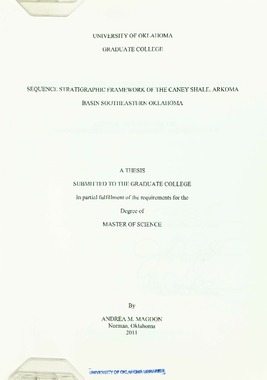| dc.contributor.author | Magoon, Andrea Marie | |
| dc.coverage.spatial | Arkoma Basin (Ark. and Okla.) | |
| dc.coverage.spatial | Arkoma Basin (Ark. and Okla.) | |
| dc.date.accessioned | 2020-01-27T18:00:10Z | |
| dc.date.available | 2020-01-27T18:00:10Z | |
| dc.date.created | 2011 | |
| dc.date.issued | 2011 | |
| dc.identifier.uri | https://hdl.handle.net/11244/323320 | |
| dc.description | Accompanied by one folded plate in pocket. | |
| dc.description | Thesis (M.S.)--University of Oklahoma, 2011. | |
| dc.description | Includes bibliographical references (leaves 95-97). | |
| dc.description.abstract | Many petroleum companies have turned their attention to the exploration and development of shale as unconventional resource plays. The focus of this study was the Caney Shale, which occurs in the Oklahoma part of the Arkoma Basin. The Caney is part of a larger group of formations from the top of the Hunton Limestone , upward through the Goddard shale. The Caney is an unconventional reservoir. The beds within the Caney vary in thickness from a few feet to over 20ft and are laterally persistent for miles. Although Caney production has occurred since 2005, producing approximately 1 BCF and 17 MBO, explanations of the geology of the field are not consistent among industry geologists.
Few studies have implemented the use of high frequency sequence stratigraphy in shales. Developing a detailed stratigraphic framework for the Caney, including depositional settings, reservoir characterization, petrophysical responses, and organic content, was the goal of this thesis. Four cores were utilized within the study area. The Cometti 2H-13 core was the primary core of interest due to its total coverage length. The Cometti was drilled by Newfield in April of 2007. Core was taken from the Sylvan Formation up through the Goddard Formation. In this core, the Caney shale is a dark grey
to black shale, containing pyrite concretions, carbonate laminae, algal cysts, shell fragments and lag deposits. Six different facies were identified in the core: Massive bed, Non-Fossil Bearing, Massive Bed, Fossil Bearing , Faintly Laminated Bed: Non-Fossil Bearing , Faintly Laminated Bed: Fossil Bearing, Highly Laminated Bed: Non-Fossil Bearing and Highly Laminated Bed: Fossil Bearing. The core facies analysis performed on the Cometti showed an overall trend from the Massive beds: Non- and Fossil- Bearing up to Highly Laminated Beds: Non- and Fossil- Bearing.
Sequence stratigraphic features identified on gamma ray logs within the study area are as follows. : Transgressive Systems Tract (TST) is characterized by a fining upward pattern or an increase in gamma ray APT values. Regressive Systems Tract (RST) is characterized by a coarsening up pattern or a decrease in gamma ray. Sequence Boundary (SB) and Transgressive Surface of Erosion (TSE) comprise a compound surface formed during different stages of a sea level cycle. TSE occurs at the base of a TST. Flooding Surface (FS) occurs at the top of the TST . The Maximum Flooding Surface (MFS) occurs at the top of a Condensed Section (CS) and is characterized by the highest API reading and the finest grained shale.
The sequence stratigraphic framework developed from the core was applied to correlating digital well logs on 25 cross sections. To properly correlate the Caney from well to well, IO FS and IO TSE stratigraphic markers were picked; from those markers, 19 intervals were identified and mapped. Three main intervals of deposition were identified from the overall directions of each interval. Mapping each interval separately allowed for more accurate mapping and led to a better understanding of the depositional patterns of the strata. Comparison among the cycles from core analysis showed that Cycle 1 was transported and deposited from the west and Cycle 2 was transported and deposited from the northwest-southeast.
Shale's are becoming a prime target for exploration. A detailed stratigraphic
framework leads to an improved understanding of reservoirs, advance exploration and develops plays. | |
| dc.format.extent | xv, 97 leaves | |
| dc.format.medium | xv, 97 leaves : ill. (chiefly col.), maps (chiefly col.) ; 30 cm. | |
| dc.language.iso | eng | |
| dc.subject.lcsh | Oil-shales--Arkoma Basin (Ark. and Okla.) | |
| dc.subject.lcsh | Sequence stratigraphy | |
| dc.subject.lcsh | Geology--Arkoma Basin (Ark. and Okla.) | |
| dc.title | Sequence stratigraphic framework of the Caney Shale, Arkoma Basin southeastern Oklahoma | |
| dc.type | Text | |
| dc.contributor.committeeMember | Donaldson, William, A | |
| dc.contributor.committeeMember | Pigott, John, D | |
| dc.contributor.committeeMember | Slatt, Roger, M | |
| ou.group | Conoco Phillips School of Geology and Geophysics | |

